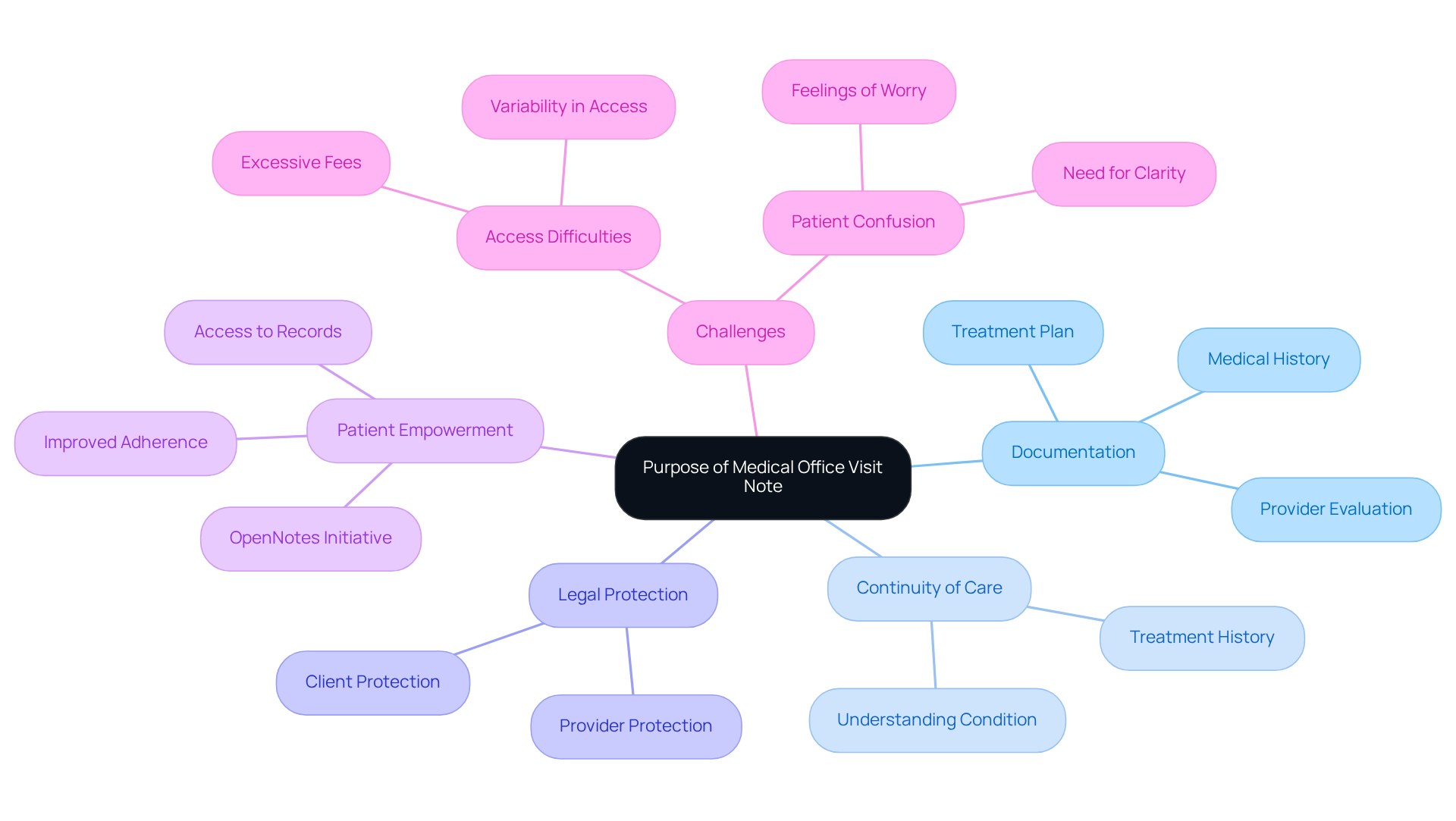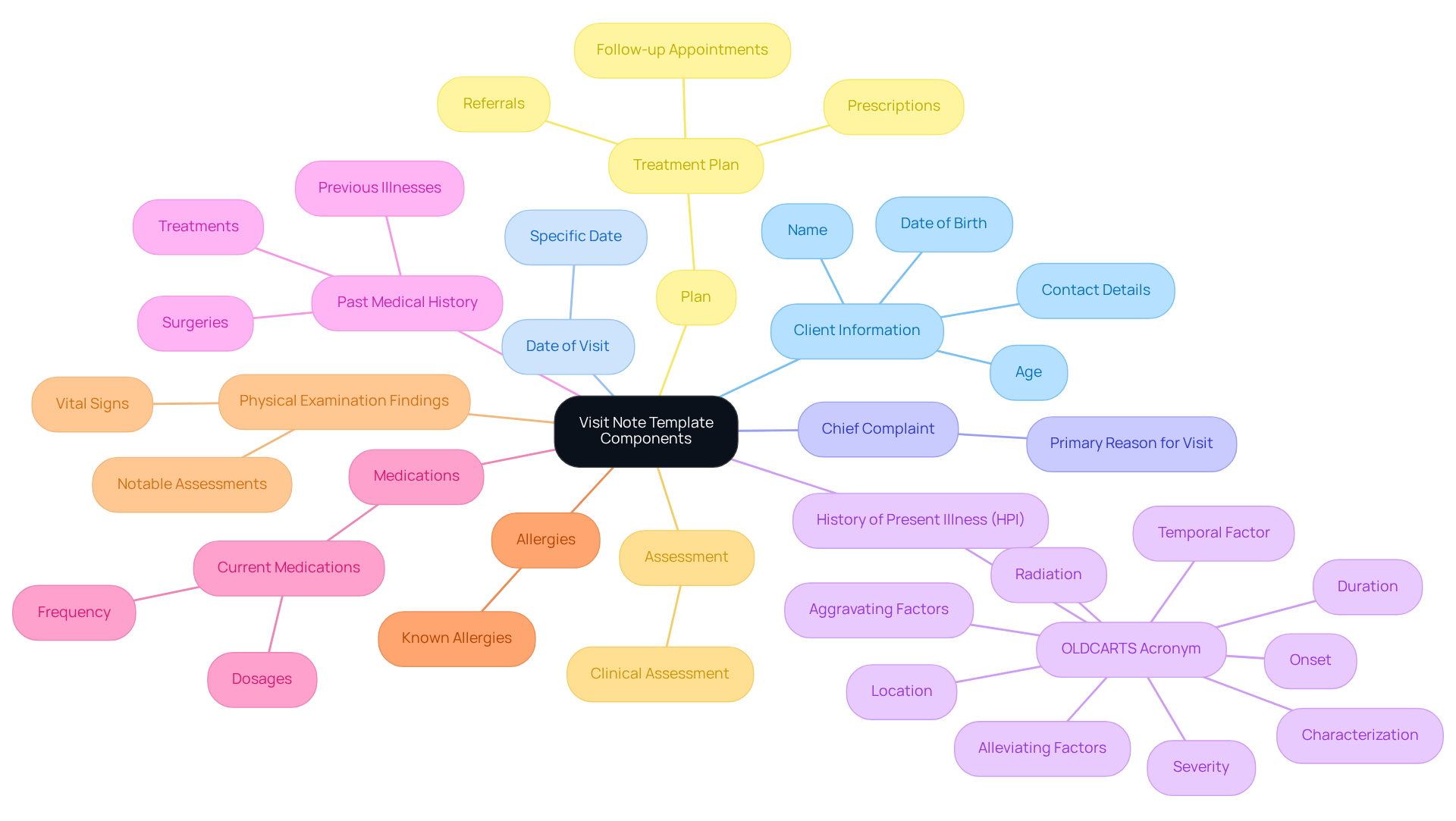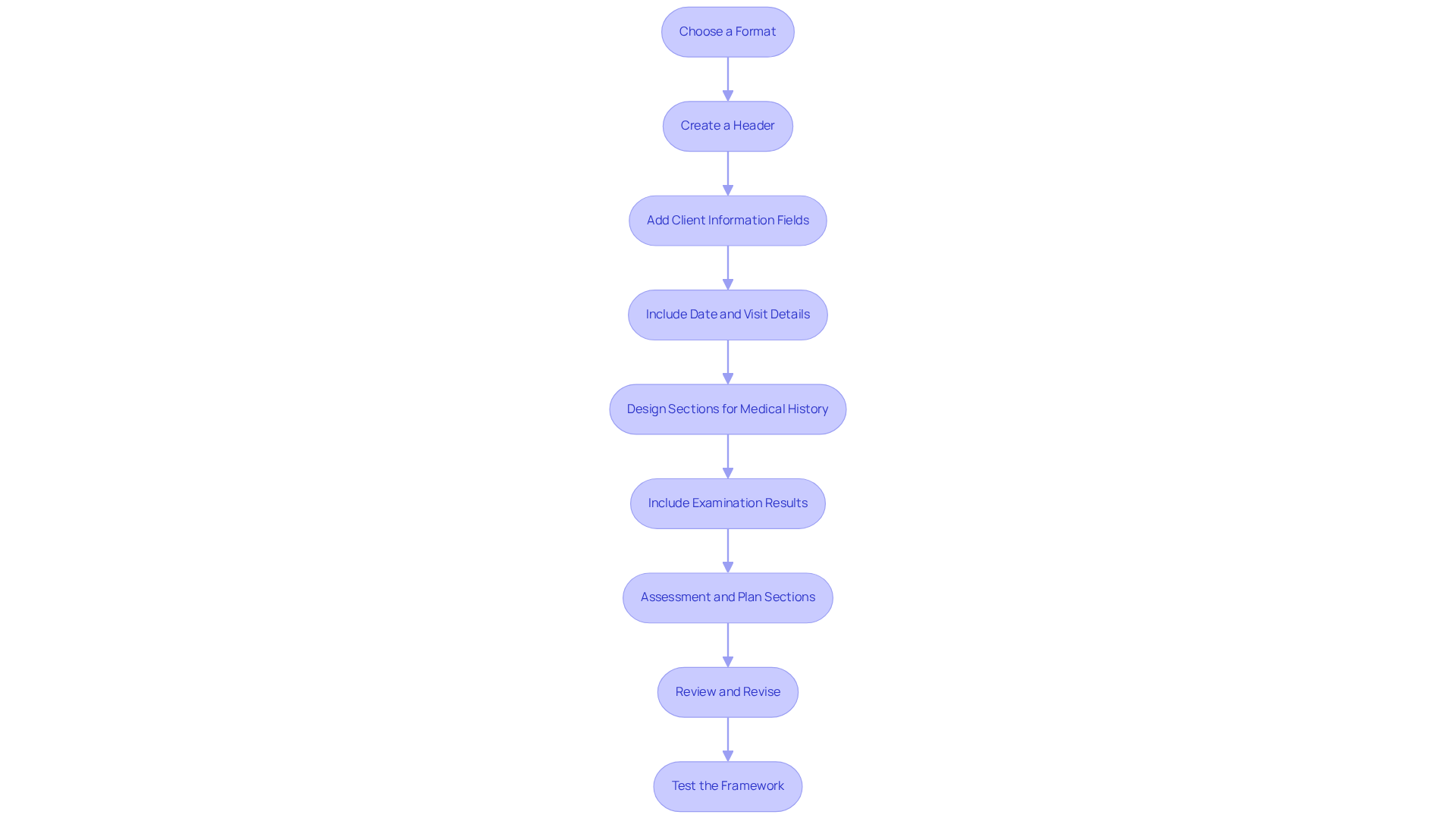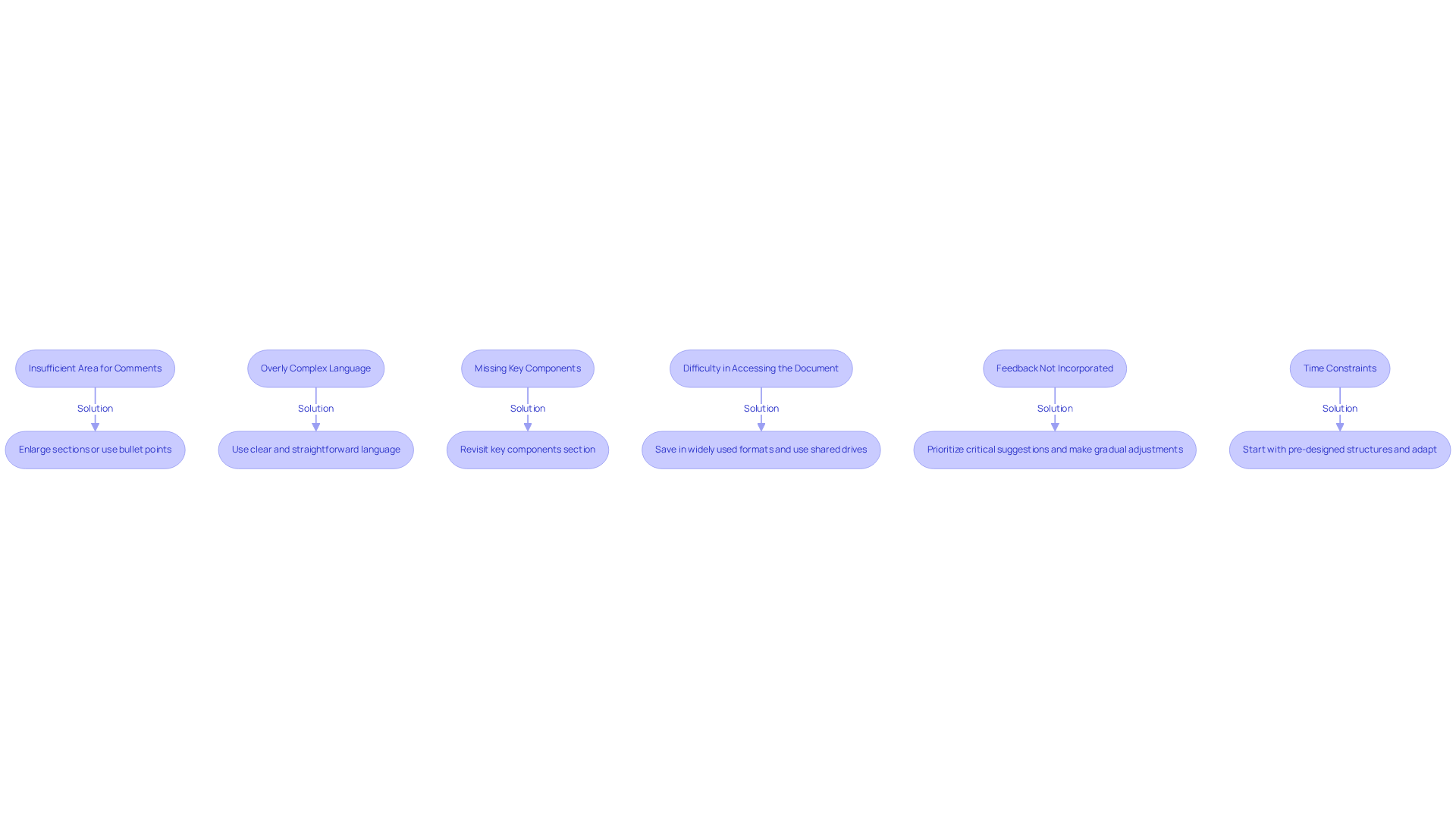Overview
This article serves as a compassionate guide for healthcare providers, offering a step-by-step approach to creating a medical office visit note template. It recognizes the emotional challenges faced in the healthcare environment and emphasizes the vital role of structured documentation in alleviating some of these burdens. By outlining essential components, such as client information, medical history, and treatment plans, it addresses how these elements can enhance patient care and communication among providers.
Have you ever felt overwhelmed by the administrative tasks that seem to take time away from patient interaction? This guide not only identifies these common challenges but also provides practical solutions to ensure that your documentation is both effective and user-friendly. By implementing this template, you can streamline your processes, allowing for more meaningful connections with your patients.
Ultimately, the goal is to support better patient care and foster collaboration within healthcare teams. We invite you to explore this guide further and consider how these strategies can make a difference in your practice. Together, we can enhance the quality of care delivered to those who need it most.
Introduction
Creating an effective medical office visit note is not merely a bureaucratic necessity; it stands as a cornerstone of quality healthcare. These notes encapsulate vital information that ensures continuity of care, protects legal interests, and empowers patients to actively engage in their health journey.
However, many healthcare providers face emotional challenges when navigating the intricacies of crafting comprehensive and clear documentation templates.
How can one effectively manage the complexities of medical record-keeping while ensuring that all essential components are meticulously captured?
This guide offers a supportive, step-by-step approach to developing a robust medical office visit note template, enhancing both communication and patient care.
Understand the Purpose of a Medical Office Visit Note
A medical office visit record plays a crucial role in healthcare. It not only documents an individual's medical history but also outlines the reason for the visit, details the healthcare provider's evaluation, and specifies the treatment plan. This documentation is essential for ensuring continuity of care, allowing other healthcare professionals to understand the individual's condition and treatment history effectively.
Moreover, these records serve as legal instruments, protecting both the client and the provider in case of disagreements. Have you ever thought about how access to medical records can empower individuals? Studies show that when people can review their medical records, they often feel more in control of their care, leading to improved adherence to treatment plans. However, it’s important to acknowledge that a small fraction of individuals, particularly between 1% to 8%, report feelings of confusion, worry, or offense after reviewing their notes. This highlights the need for clarity in record-keeping.
Dr. Harlan Krumholz emphasizes the challenges faced by individuals, stating, 'What is clear from this is, it is hard for Americans to get access to their own medical records.' Initiatives like the OpenNotes project are designed to promote transparency and encourage individuals' involvement in their healthcare. By understanding these objectives, you can develop a thorough and efficient visit document structure that meets both clinical and administrative needs. Ultimately, this will enhance the for individuals, fostering a supportive and compassionate healthcare environment.

Identify Key Components of the Visit Note Template
A well-organized medical office visit note template is crucial for effective documentation and communication among healthcare providers. It’s important to recognize the emotional challenges that come with ensuring accurate records. A structured approach can alleviate some of the administrative burdens that impact patient care. Here are the key components that should be included:
- Client Information: Capture the individual's name, age, date of birth, and contact details to ensure accurate identification.
- Date of Visit: Record the specific date when the individual was seen to maintain a clear timeline of care.
- Chief Complaint: Provide a concise statement of the primary reason for the visit, guiding the focus of the consultation.
- History of Present Illness (HPI): Include detailed information about the individual's current condition, covering aspects such as onset, duration, and associated symptoms. Utilizing the (Onset, Location, Duration, Characterization, Alleviating and Aggravating factors, Radiation, Temporal factor, Severity) can enhance clarity and assist in organizing medical history.
- Past Medical History: Summarize relevant medical history, including previous illnesses, surgeries, and treatments that may impact current care.
- Medications: List current medications, specifying dosages and frequency to avoid potential drug interactions and ensure continuity of care.
- Allergies: Document any known allergies to medications or substances to prevent adverse reactions.
- Physical Examination Findings: Record objective findings from the examination, such as vital signs and any notable physical assessments.
- Assessment: Provide the provider's clinical assessment based on the gathered information, synthesizing subjective and objective data to arrive at a diagnosis.
- Plan: Outline the treatment plan, including prescriptions, referrals, and follow-up appointments, ensuring that all necessary steps are clearly communicated.
Integrating these elements into the medical office visit note template not only aids comprehensive recording but also fosters communication among healthcare professionals, ultimately enhancing care results. Research shows that organized documentation methods can significantly lower claim rejection rates. For instance, one study revealed a drop from 32% to 8% after implementing structured SOAP templates, alongside a 15% increase in satisfaction scores. This underscores the importance of a thorough strategy for medical documentation. As Vivek Podder observed, "The SOAP documentation assists healthcare professionals in utilizing their clinical reasoning to evaluate, diagnose, and manage a patient based on the information supplied by them." Additionally, leveraging AI-driven tools like Heidi can streamline documentation processes, further enhancing efficiency and job satisfaction among healthcare providers. How might these strategies improve your daily practice?

Develop the Template: Step-by-Step Instructions
To develop a , it is crucial to approach this task with care and understanding. Here are some thoughtful steps to guide you:
- Choose a Format: Consider whether a digital layout using software like Microsoft Word or Google Docs would best suit your needs, or if a paper-based version is preferable. Digital models offer the convenience of easy alterations and distribution, making them a practical choice.
- Create a Header: Start by prominently including your practice's name, address, and contact information at the top of the template. This ensures that essential details are readily available.
- Add Client Information Fields: Design sections for crucial demographics, such as name, age, and contact details. This ensures that all relevant information is captured, allowing for a more personalized approach to care.
- Include Date and Visit Details: Incorporate fields for the date of the visit and the chief complaint. This context is invaluable for understanding the patient’s needs during the encounter.
- Design Sections for Medical History: Establish subsections for the history of present illness (HPI), past medical history, current medications, and allergies. This facilitates a comprehensive assessment of each individual, helping you provide the best possible care.
- Include Examination Results: Create a specific section for recording physical examination results. Provide space for both objective observations, such as vital signs, and subjective accounts, like patient complaints. This dual approach enriches your understanding of the patient’s condition.
- Assessment and Plan Sections: Clearly delineate sections for the provider's assessment and the treatment plan. This allows for detailed notes that guide care, ensuring that every aspect of the visit is thoughtfully considered.
- Review and Revise: After drafting the outline, take a moment to examine it for completeness and clarity. Revise as necessary to ensure it aligns with your practice's specific needs and workflows. This step is crucial for creating a functional tool that truly serves you and your patients.
- Test the Framework: Use the framework during real client appointments to identify areas for enhancement. Gather feedback from colleagues to improve usability and effectiveness. Their insights can be invaluable in refining your approach.
By following these steps, you will create a thorough and functional framework for a medical office visit note template that simplifies record-keeping and enhances care for individuals. This method not only boosts efficiency but also aligns with the growing trend towards digital documentation. In fact, more than 75% of healthcare providers report that time spent on EHR tasks could be better utilized for patient care. Moreover, 41% of providers recognize staff training as a significant obstacle with their existing EHR, underscoring the need for a well-structured framework that enhances usability.

Troubleshoot Common Issues in Note Creation
Developing a medical office visit record framework can indeed present various challenges that may feel overwhelming. However, by addressing these common obstacles with effective troubleshooting strategies, you can enhance your documentation process and ultimately improve patient care:
- Insufficient Area for Comments: If your layout lacks adequate space for comprehensive comments, consider enlarging sections or using bullet points to summarize information without sacrificing clarity. Research indicates that enhancing physician note formats can save an average of 2.6 hours daily for providers, underscoring the importance of sufficient space in documentation.
- Overly Complex Language: It’s crucial to ensure that the language in your template is clear and straightforward. Avoid medical terminology that might confuse other healthcare providers or individuals, fostering better understanding and communication. Experts highlight that clear communication is vital for effective patient care.
- Missing Key Components: If you notice any absent crucial elements, revisit the key components section to ensure all necessary fields are included. This will enhance the document's comprehensiveness. Uniform frameworks have shown their ability to without extending the time dedicated to writing, making it essential to incorporate all pertinent elements.
- Difficulty in Accessing the Document: For digital files, save them in widely used formats (like PDF or DOCX) and ensure they are easily accessible to all staff members. Utilizing shared drives or cloud storage can facilitate this. A case study from Sunny Peak Health System revealed that improving access to recording tools led to a 61% reduction in provider time spent on clinical records after work hours.
- Feedback Not Incorporated: If you receive feedback from colleagues but find it challenging to implement, prioritize the most critical suggestions and make gradual adjustments to the document. This approach fosters collaboration and improvement. Mahaya Walker notes that customized record solutions can significantly enhance workflow efficiency and provider satisfaction.
- Time Constraints: When time is limited, consider starting with pre-designed structures and adapting them to fit your practice's needs. This method can save time while ensuring comprehensive records. The use of efficient documentation formats has been linked to higher provider satisfaction across various healthcare environments.
By proactively addressing these issues, you can significantly enhance the effectiveness of your medical office visit note template. This not only improves the overall documentation process but also supports better patient care, allowing you to focus on what truly matters.

Conclusion
Creating an effective medical office visit note template is essential for enhancing patient care and ensuring accurate documentation. Have you ever felt overwhelmed by the demands of administrative tasks? This guide emphasizes the importance of a well-structured framework that captures vital patient information and promotes seamless communication among healthcare providers. By understanding the purpose and key components of these notes, healthcare professionals can significantly improve the quality of care delivered to individuals.
The article outlines crucial elements to include in a visit note, such as:
- Client information
- Chief complaints
- Medical history
- Treatment plans
Organized documentation plays a vital role in reducing claim rejection rates and improving overall patient satisfaction. By following a step-by-step approach to developing the template, healthcare providers can create a functional and efficient record-keeping system that addresses common challenges faced during the documentation process.
Ultimately, prioritizing clear and comprehensive medical office visit notes can lead to better patient outcomes and foster a supportive healthcare environment. Embracing structured documentation practices not only enhances the efficiency of healthcare delivery but also empowers individuals to take an active role in their care. By implementing these strategies, healthcare professionals can ensure that every patient visit is documented meticulously, paving the way for improved continuity of care and patient satisfaction. Together, let’s strive for a healthcare system that values every detail of patient interactions.




